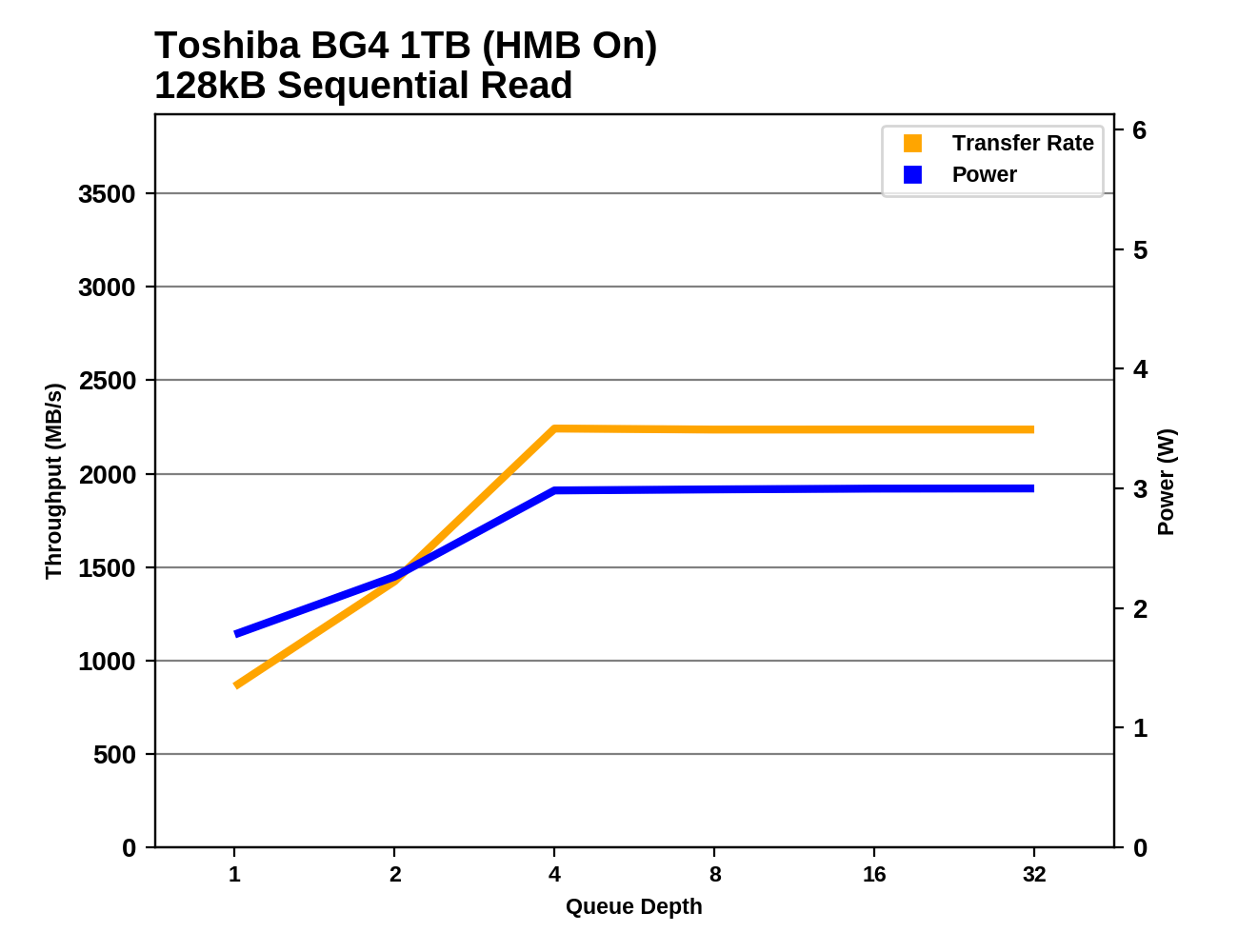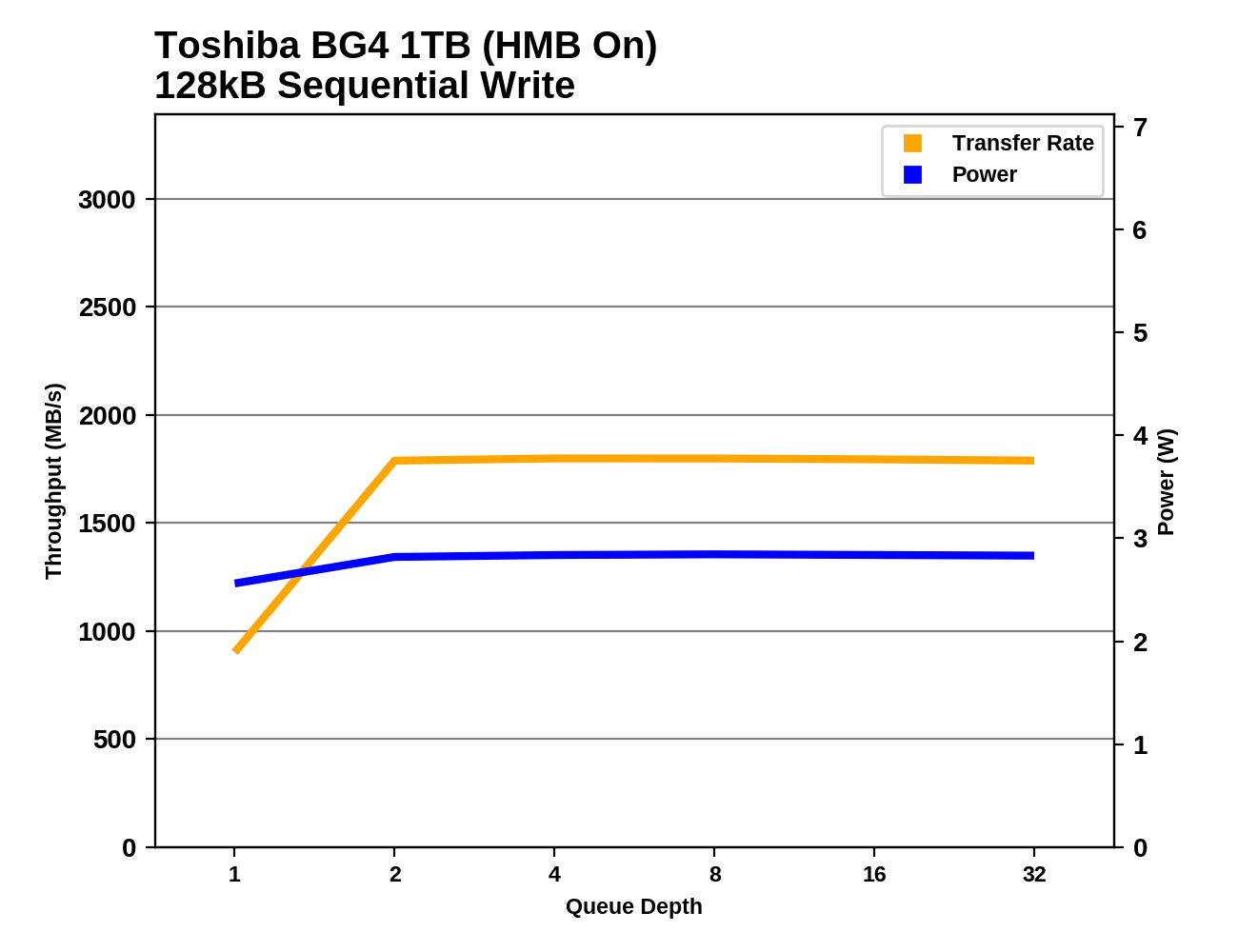The Toshiba/Kioxia BG4 1TB SSD Review: A Look At Your Next Laptop's SSD
by Billy Tallis on October 18, 2019 11:30 AM ESTSequential Read Performance
Our first test of sequential read performance uses short bursts of 128MB, issued as 128kB operations with no queuing. The test averages performance across eight bursts for a total of 1GB of data transferred from a drive containing 16GB of data. Between each burst the drive is given enough idle time to keep the overall duty cycle at 20%.

The burst sequential read speed of the Toshiba/Kioxia BG4 is about 1GB/s: way below par for high-end NVMe SSDs, but fine for an entry-level drive. It's not too far behind Toshiba's own XG6 high-end drive, which turns in a fairly disappointing score on this test.
Our test of sustained sequential reads uses queue depths from 1 to 32, with the performance and power scores computed as the average of QD1, QD2 and QD4. Each queue depth is tested for up to one minute or 32GB transferred, from a drive containing 64GB of data. This test is run twice: once with the drive prepared by sequentially writing the test data, and again after the random write test has mixed things up, causing fragmentation inside the SSD that isn't visible to the OS. These two scores represent the two extremes of how the drive would perform under real-world usage, where wear leveling and modifications to some existing data will create some internal fragmentation that degrades performance, but usually not to the extent shown here.

On the longer sequential read test that brings in some higher queue depths, the BG4 maintains decent performance even while some high-end drives fall down to its level. The BG4's performance reading back data that wasn't written sequentially is particularly good, and at least a bit faster than most high-end NVMe drives can manage.
 |
|||||||||
| Power Efficiency in MB/s/W | Average Power in W | ||||||||
The Toshiba BG4 uses significantly more power during the sequential read test than the older BG3-based RC100, but the performance improvements make that power well-spent. The BG4's power efficiency scores are excellent and beat most high-end NVMe drives.
 |
|||||||||
With HMB on, the BG4's sequential read speed tops out at QD4 or higher and is quite steady. Without HMB, it scales more gradually and ultimately is slightly slower at high queue depths.
The BG4 certainly isn't the fastest SSD on this test with a top sequential read speed a bit above 2GB/s, but for the speeds it does provide the BG4 is one of the most power-efficient drives we have ever tested.
Sequential Write Performance
Our test of sequential write burst performance is structured identically to the sequential read burst performance test save for the direction of the data transfer. Each burst writes 128MB as 128kB operations issued at QD1, for a total of 1GB of data written to a drive containing 16GB of data.

HMB didn't matter much for the burst sequential read test, but for the burst sequential write test it is very helpful, bringing the BG4's performance almost up to the level of most high-end NVMe SSDs.
Our test of sustained sequential writes is structured identically to our sustained sequential read test, save for the direction of the data transfers. Queue depths range from 1 to 32 and each queue depth is tested for up to one minute or 32GB, followed by up to one minute of idle time for the drive to cool off and perform garbage collection. The test is confined to a 64GB span of the drive.

On the longer sequential write test, the BG4 with HMB still manages to be trailing close behind the high-end NVMe drives, and far ahead of most of the other entry-level NVMe competition. With HMB off the BG4 is much slower, but still acceptably fast for an entry-level drive.
 |
|||||||||
| Power Efficiency in MB/s/W | Average Power in W | ||||||||
The BG4 doesn't have the lowest power consumption on the sequential write test, but it does set the record for power efficiency. Even with HMB off the performance remains high enough to give the BG4 a competitive efficiency score.
 |
|||||||||
The BG4 hits full sequential write speed with a queue depth of two or higher, and the performance is very steady after that with no sign of the SLC cache running out. Without HMB, it is limited to about 1GB/s, significantly slower than even the Intel 660p QLC SSD.
At QD2 and higher, the BG4 is one of the most efficient drives we have tested: anything with better sequential write performance is clearly drawing more power, and anything with significantly lower power consumption is also significantly slower.












31 Comments
View All Comments
eek2121 - Sunday, October 20, 2019 - link
There are a few 4 TB m.2 SSDs out there, they just sell out FAST so you typically won't even find them listed. You can still find plenty of 2 TB m.2 SSDs.mxnerd - Saturday, October 19, 2019 - link
Kioxia? Great product but what a bad brand name.s.yu - Sunday, October 20, 2019 - link
No surprise coming from Japanese manufacturers recently........s.yu - Sunday, October 20, 2019 - link
Looks like the takeaway from this is although Toshiba SSDs consistently fall behind Samsungs (the main reason they're regarded as the short straw in flash lottery), they may be more efficient, but hardly anybody tests for that.discostrings - Sunday, October 20, 2019 - link
The Toshiba BG4 is actually already available in the M.2 2242 format in retail channels as the Sabrent SB-1342-2TB, SB-1342-1TB, and SB-1342-512:https://www.sabrent.com/product/SB-1342-2TB
Yes, that's right: there's a 2TB 2242 variant! I was hesitant to believe it was actually available in that capacity, as I didn't see any sort of announcement, but I received one on Thursday and I can confirm it's quite real.
Unfortunately, these aren't useful for most current laptops with 2242 slots (that are primarily included for WWAN but which can also use NVMe drives like the RC100). As these SSDs use four PCIe lanes, they require the M key, while all laptops that I know of direct two (or less) PCIe lanes to the 2242 slot, and thus have a B key that prevents use of these drives.
So there probably won't be much of a market for these until there are laptops out with M-keyed M.2 2242 slots. It would be great to see a 2-lane variant with a B key in the short term for use in current laptops.
discostrings - Sunday, October 20, 2019 - link
I mixed terminology up a little bit in my prior post. The Sabrent drives use Toshiba BiCS4 NAND (which is also used by in the Toshiba BG4), but these are not rebranded variants of the same drive. Apologies for any confusion.peevee - Monday, October 21, 2019 - link
So they already have brands Toshiba, Lite-On and Plextor, all pretty valuable and respectable (esp Plextor I think), why do they feel like they need another one?Billy Tallis - Monday, October 21, 2019 - link
The decision to rebrand from Toshiba to Kioxia was made before the decision to buy Lite-On's SSD business. Continuing to use the Toshiba brand name long-term isn't an option since they aren't part of the Toshiba conglomerate anymore and need to IPO under a name they own. They don't get to use the Lite-On name either because they didn't buy the whole company, just the SSD portion. They might now own the Plextor brand.Targon - Monday, October 21, 2019 - link
If the laptop maker has a decent design, then it would make more sense to go with a small capacity SSD to keep the laptop price down and then put a better SSD in yourself. Get something with a normal 1TB hard drive but has the support for NVMe, and you then throw in a 1TB drive yourself. No need to feed the stupidity of people wanting a tiny machine that has a slow processor just to keep power demands low. Going with even a 35 or 45 watt CPU with a 15 inch display will give you a much more powerful laptop than these 15W CPU machines with a 11 inch screen designed for people who sit in meetings all day but have much lower performance.At least we are beyond the days of Intel Atom crap machines in that space.
MykeM - Thursday, October 31, 2019 - link
You can actually get a external USB-C SSD that uses this particular Toshiba BG4 SSD. It’s made by CalDigit know for its excellent Thunderbolt 3 docks. It’s called Tuff Nano and at the moment only comes in the ½ terabyte capacity. The read speed is just over 1GB/s (if the device USB-C supports USB3.x Gen2). And it’s tiny:l:https://www.caldigit.com/tuff-nano